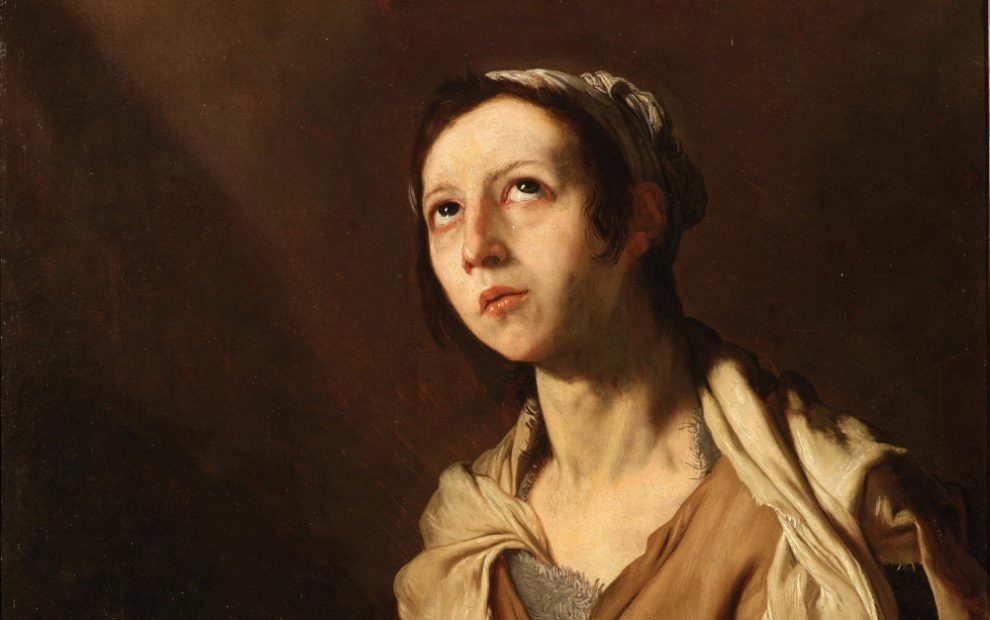Some time in the seventh century, Sophronius, patriarch of Jerusalem, set down the story of Mary of Egypt, who once lived in the desert region of Judea that lies between Jerusalem and the Dead Sea. The desert ascetics, as they came to be known, were mostly men who had renounced all creature comforts to pursue a life of prayer. It was unusual for a woman to retire to the desert—but then, everything about Mary’s story is suffused with mystery.
We could start at the beginning. But whose beginning? Mary’s story is no simple arc from birth to death. Her biography crisscrosses the lives of several individuals who claimed to have known about her or claim to have known someone who encountered her. Catholics generally believe she was born around 344 and that she lived into her 70s. In the tradition of the Orthodox Church, she lived and died about 100 years later.
The Dutch theologian Henri Nouwen writes that Roman Egypt and nearby Judea during this early period were spiritually tepid, power-hungry societies where “the radical call of Christ to leave father, mother, brother, and sister, to take up the cross and follow him, had been watered down to an acceptable and comfortable religiosity and had lost its converting power.” Jerusalem itself had grown into a splendid city whose shrines and architecture were rapidly becoming a magnet for Christian pilgrims and sightseers, thanks to Constantine’s mother, who toured the region in search of Christian relics.
According to an account by a Christian monk that predates that of Sophronius, Mary was a cantor at Jerusalem’s Church of the Resurrection—today the Church of the Holy Sepulchre—until something happened that caused a scandal. The details are sparse, but it’s possible that Mary attracted male attention, was assaulted, and was sent to the monastery for a period of time (the standard therapy for a sexually assaulted female deacon). Mary prayed to be relieved of the scandal, eventually withdrawing to the desert. In a later version of the story told by John Moschus, Mary was a nun who believed that she was the target of a young man’s satanic desire and fled to the desert to remove his temptation.
Around 634, Sophronius began working on his version of the life of Mary, which tilts away from the theme of refuge, doubles down on female sexual sin and penitence, and invites us—quite by accident—to think in new ways about the power of saints’ lives. This account, known as the Vita of St. Mary of Egypt, relies exclusively on the words of a monk, Zosima, who says he met Mary after she had lived in the desert for many years.
In this version of events, Mary (through Zosima), reveals a life of eye-popping debauchery starting at age 12, when she ran away from her loving family in Alexandria to have sex with as many men as possible. In one incident, she encounters about a dozen young, attractive men on the shore and winds up on a boat bound for Judea, forcing the young men to sexually satisfy her, often against their will.
In Judea, in Sophronius’ version of the story, Mary tries to enter the very church where, according to the earlier account, she had once been a cantor. But she is barred by an invisible force and converts on the spot. By the time Zosima finds her in the desert, she is tanned and emaciated (from living on nothing but herbs). It has been suggested that in the desert, Mary succeeds in transforming herself into a kind of masculinized female whose sexuality no longer inspires fear and paranoia in men and must be pleasing to God. Zosima is impressed by her wisdom and sanctity and agrees to do whatever she asks, including bringing her communion and eventually burying her body on the bank of the River Jordan.
Clearly it is not just Mary’s life that is interesting; so is what has been done to it in the telling and retelling. From assaulted woman to woman-who-assaults to penitent, a question persists: Is Mary even real? What can she tell us that is not part of the male imagination responsible for her story?
Scholars agree that the hyperbole of Mary’s biography—the piling on of sexual escapades designed to offend—was intended as a rhetorical device. Unfortunately, modern retellings take them as fact. As a result, the full “history” of Mary, whoever she was or wherever she lived, is crowded out by sexual innuendo. Many contemporary retellings on blogs and parish websites spend more time on Mary’s sexual adventures than on her life in the desert, and hardly anyone mentions her “other” life as a cantor. Moreover, her characterization as a 12-year-old sex addict engages the worst stereotypes about the sexuality of Black girls and women. Gunnar Gundersen, lawyer and cofounder of Black Catholic Messenger, notes: “Mary is the most prominent female saint to emerge from North Africa, but her story is bound to be problematic for Black Catholic girls.”
Perhaps a case can be made for being a pilgrim in search of Mary, much like Richard Dawkins’ pilgrims in The Ancestor’s Tale (Mariner Books), who take an “epic pilgrimage from the present to the past.” No thread of her life should be missed. Neither should any part of her tale be claimed as fact, especially not her sexual résumé, but only as the starting point for talking about her life.
In this wider space, Mary’s connection to us begins to emerge. Too many people, as history has shown, have experienced the silencing of their own truth so that another story may be told. But if Mary endures in the midst of that confusion—and clearly, she does—so can we. We reach for her; we long to know her. And she shows us that no one can ever be truly vanished under layers of narrative paint.
This is because in all the stories of Mary, the one constant is that she freely gave herself up to that desert, alone, to deepen her relationship with God. For women in particular, the solitude of Mary’s later life offers permission to retreat from the occasionally all-consuming demands of relationship and family to be alone in God’s presence in nature. Our desert does not have to be far away. It can be anywhere—a walking trail or a quiet park or ravine—that invites us in, a place where bringing oneself is enough and where it is safe to reflect on what we do not share so easily with others.
Even if Mary’s biography perplexes us, we can recognize that by not knowing (and not needing to know) which version of her story is “the truth,” we honor her privacy and integrity. Since there is no way of proving which of these accounts presents a factual story, let us also resist the urge to force her life into a statement about sexual addiction or purity culture.
Ultimately, where we encounter Mary will depend on our orientation to her. But when we do, she deserves our humblest attention, equal to the mystery that she is.
This article also appears in the April 2023 issue of U.S. Catholic (Vol. 88, No. 4, pages 16-18). Click here to subscribe to the magazine.
Image: Mary of Egypt, Jusepe de Ribera, 1651, oil on canvas. WIkimedia Commons.













Add comment